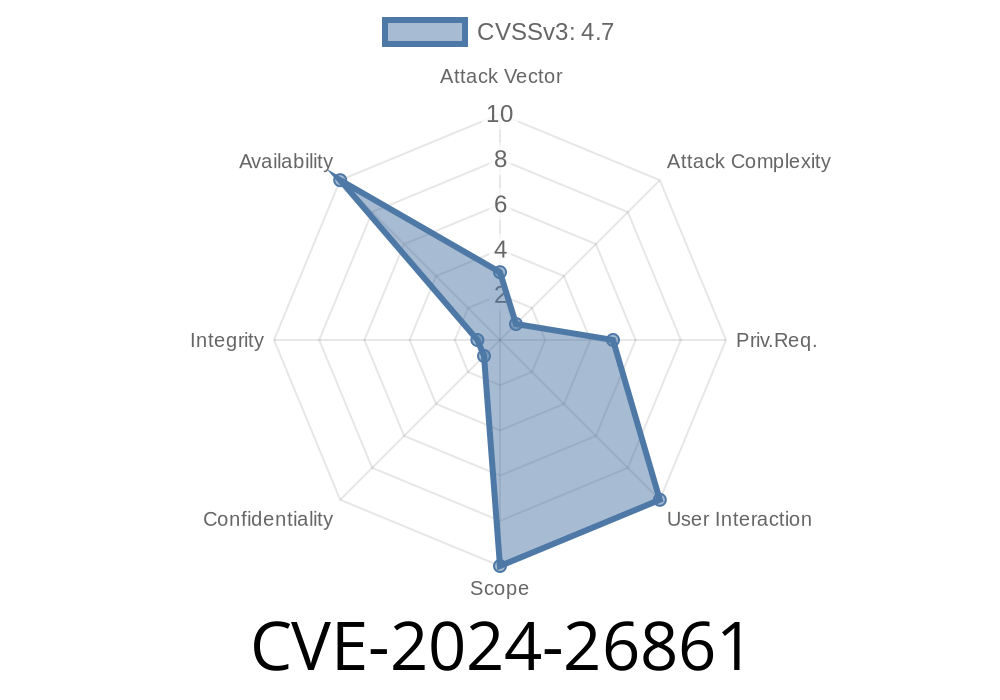In early 2024, a subtle but important vulnerability was discovered and fixed in the Linux kernel’s implementation of WireGuard, the popular VPN protocol. This issue, tracked as CVE-2024-26861, involved a data-race condition on the receiving_counter.counter within WireGuard’s packet receive path. Let's break down what happened, why it mattered, and how developers remediated the risk—using clear, simple language.
What is a Data Race?
A data race happens when two or more parts of a program (often running on different CPUs) try to access the same memory location at the same time, at least one of them writing. This can lead to unpredictable behavior, especially dangerous in a kernel context.
Where Did the Problem Occur?
Within WireGuard’s code, the variable keypair->receiving_counter.counter was being read and written from different code paths running concurrently—one part in the network receive handler (potentially interrupt context) and another in a workqueue. Here’s a simplified version of the scenario:
Syzkaller & KCSAN Reports
Tools like Syzkaller and KCSAN found this issue automatically, reporting:
BUG: KCSAN: data-race in wg_packet_decrypt_worker / wg_packet_rx_poll
write to xffff888107765888 of 8 bytes by interrupt on cpu :
counter_validate drivers/net/wireguard/receive.c:321 [inline]
wg_packet_rx_poll+x3ac/xf00 drivers/net/wireguard/receive.c:461
...
read to xffff888107765888 of 8 bytes by task 3196 on cpu 1:
decrypt_packet drivers/net/wireguard/receive.c:252 [inline]
wg_packet_decrypt_worker+x220/x700 drivers/net/wireguard/receive.c:501
...
Here’s a simple snippet (not the full source) to illustrate the pattern
// Before fix
keypair->receiving_counter.counter++; // (writer)
...
if (keypair->receiving_counter.counter > max) // (reader)
do_something();
In systems with many CPUs, without proper protection, counter++ and reading counter can overlap, leading to a race.
The Fix: Using READ_ONCE and WRITE_ONCE
The kernel provides READ_ONCE() and WRITE_ONCE() macros. These ensure the compiler and CPU do not optimize away important access patterns, making explicit that a concurrent (possibly racy) access is intentional.
After the fix
#include <linux/compiler.h> // For WRITE_ONCE, READ_ONCE
// Writer
WRITE_ONCE(keypair->receiving_counter.counter,
keypair->receiving_counter.counter + 1);
// Reader
if (READ_ONCE(keypair->receiving_counter.counter) > max)
do_something();
By annotating these accesses, developers tell analysis tools:
> "We know this can race, and it's a conscious design with tolerable effects."
Why Not Use a Lock?
While lock-based synchronization is a classic way to avoid races, in high-performance network paths (especially in a VPN context like WireGuard), adding locks can introduce unacceptable latency or bottlenecks. In this situation, the designers knew a race may happen—but it's safe because the counter's correctness is only *statistically relevant*, and occasional staleness is acceptable.
Not a direct privilege escalation or memory corruption.
- Could, in theory, lead to duplicated (replayed) or dropped packets, affecting reliability or throughput.
- It does not let attackers hijack the connection, but could—if left unchecked—be a stepping stone for denial-of-service or protocol disruption if combined with other bugs.
Exploit Pathways?
*There is no practical exploit that grants code execution*.
However, an attacker with the ability to precisely time or flood packets might have been able to influence packet counters to trigger wireguard protocol errors or minor DoS.
Official Reference & Patch Links
- Linux kernel commit fixing CVE-2024-26861 (Git)
- WireGuard mailing list mention (LKML)
- Syzkaller Tool
- KCSAN Documentation
Conclusion
CVE-2024-26861 highlights the importance of both automated tools (Syzkaller, KCSAN) and careful code annotation in high-concurrency kernel code. The vulnerable code wasn’t catastrophic—but even 'benign' races can chip away at reliability or amplify other bugs. WireGuard’s maintainers acted quickly, showing best practices in upstream kernel development.
Stay tuned and keep kernels up to date—modern fuzzing finds more than yesterday’s bugs.
*This breakdown is exclusively assembled for you, focusing on digestible details and real-world context. For Linux administrators and developers: patch promptly, and subscribe to kernel mailing lists for the latest in vulnerability management.*
Further Reading
- WireGuard Security Model
- Linux Kernel Documentation on Concurrency
*Got kernel security insights or stories? Share them below!*
Timeline
Published on: 04/17/2024 11:15:08 UTC
Last modified on: 04/02/2025 13:16:54 UTC
